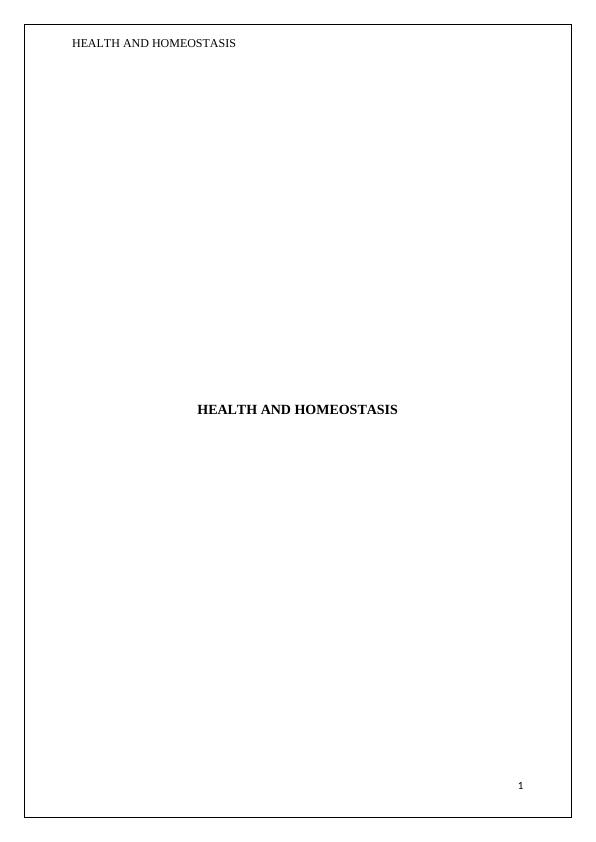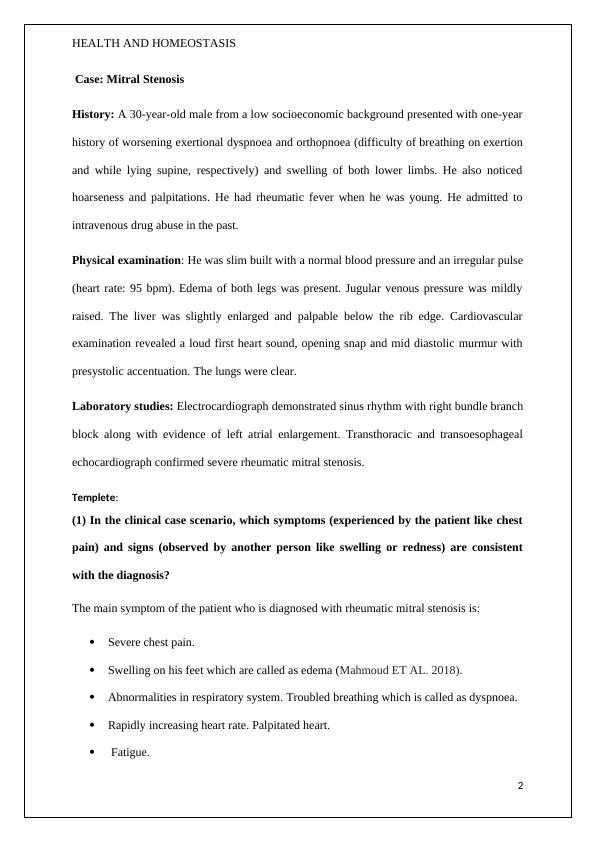Health and Homeostasis: Mitral Stenosis Case Study
Added on 2023-04-04
6 Pages1343 Words437 Views
HEALTH AND HOMEOSTASIS
HEALTH AND HOMEOSTASIS
1
HEALTH AND HOMEOSTASIS
1

HEALTH AND HOMEOSTASIS
Case: Mitral Stenosis
History: A 30-year-old male from a low socioeconomic background presented with one-year
history of worsening exertional dyspnoea and orthopnoea (difficulty of breathing on exertion
and while lying supine, respectively) and swelling of both lower limbs. He also noticed
hoarseness and palpitations. He had rheumatic fever when he was young. He admitted to
intravenous drug abuse in the past.
Physical examination: He was slim built with a normal blood pressure and an irregular pulse
(heart rate: 95 bpm). Edema of both legs was present. Jugular venous pressure was mildly
raised. The liver was slightly enlarged and palpable below the rib edge. Cardiovascular
examination revealed a loud first heart sound, opening snap and mid diastolic murmur with
presystolic accentuation. The lungs were clear.
Laboratory studies: Electrocardiograph demonstrated sinus rhythm with right bundle branch
block along with evidence of left atrial enlargement. Transthoracic and transoesophageal
echocardiograph confirmed severe rheumatic mitral stenosis.
Templete:
(1) In the clinical case scenario, which symptoms (experienced by the patient like chest
pain) and signs (observed by another person like swelling or redness) are consistent
with the diagnosis?
The main symptom of the patient who is diagnosed with rheumatic mitral stenosis is:
Severe chest pain.
Swelling on his feet which are called as edema (Mahmoud ET AL. 2018).
Abnormalities in respiratory system. Troubled breathing which is called as dyspnoea.
Rapidly increasing heart rate. Palpitated heart.
Fatigue.
2
Case: Mitral Stenosis
History: A 30-year-old male from a low socioeconomic background presented with one-year
history of worsening exertional dyspnoea and orthopnoea (difficulty of breathing on exertion
and while lying supine, respectively) and swelling of both lower limbs. He also noticed
hoarseness and palpitations. He had rheumatic fever when he was young. He admitted to
intravenous drug abuse in the past.
Physical examination: He was slim built with a normal blood pressure and an irregular pulse
(heart rate: 95 bpm). Edema of both legs was present. Jugular venous pressure was mildly
raised. The liver was slightly enlarged and palpable below the rib edge. Cardiovascular
examination revealed a loud first heart sound, opening snap and mid diastolic murmur with
presystolic accentuation. The lungs were clear.
Laboratory studies: Electrocardiograph demonstrated sinus rhythm with right bundle branch
block along with evidence of left atrial enlargement. Transthoracic and transoesophageal
echocardiograph confirmed severe rheumatic mitral stenosis.
Templete:
(1) In the clinical case scenario, which symptoms (experienced by the patient like chest
pain) and signs (observed by another person like swelling or redness) are consistent
with the diagnosis?
The main symptom of the patient who is diagnosed with rheumatic mitral stenosis is:
Severe chest pain.
Swelling on his feet which are called as edema (Mahmoud ET AL. 2018).
Abnormalities in respiratory system. Troubled breathing which is called as dyspnoea.
Rapidly increasing heart rate. Palpitated heart.
Fatigue.
2

HEALTH AND HOMEOSTASIS
In this case study the diagnosis of this patient is:
He is suffering with troubled breathing
His heart rate is rapidly increasing. He has palpable heart now (Nakamura et al.
2016).
He has edema on his feet.
(2) Given the symptoms and signs in the clinical case scenario, which organs, tissues
and/or body parts are involved or affected by the homeostatic disturbance?
In case of the rheumatic mitral valve stenosis heart is mostly affected with this disease. Mitral
valve is the very important part of heart which helps the blood circulation throughout the
body (Wunderlich et al. 2019). Thus total cardiovascular system got affected. In the other
hand lungs are also get affected due to this disease. Pulmonary hypertensive positions are
found due to this disease. As irregular blood circulation condition comes muscles are also got
affected for this disease (Iung, Leenhardt and Extramiana 2018).
(3) What processes are involved that can explain the homeostatic disturbance/s in the
clinical case scenario?
The rheumatic mitral valve stenosis condition occurs when a person had been suffered with
rheumatic fever once. This condition generally described as narrowing of the mitral valve of
heart and interrupted blood flow inside the heart (Kim et al. 2015). Our heart is made up of
four particular chambers, two of the upper portions are called as atria and rest two lower
portions are called as ventricles. This left side of the heart which have one atria and one
ventricle are divided by mitral valve. Mitral valve is consists of two small tissues which are
called as leaflets. Due to the rheumatic fever the leaflets of the mitral valve getting thickened,
thus the passage of the blood flow through the mitral valve become narrowed. In normal
cases during blood flow this mitral valve of the heart opens when blood flows from left
3
In this case study the diagnosis of this patient is:
He is suffering with troubled breathing
His heart rate is rapidly increasing. He has palpable heart now (Nakamura et al.
2016).
He has edema on his feet.
(2) Given the symptoms and signs in the clinical case scenario, which organs, tissues
and/or body parts are involved or affected by the homeostatic disturbance?
In case of the rheumatic mitral valve stenosis heart is mostly affected with this disease. Mitral
valve is the very important part of heart which helps the blood circulation throughout the
body (Wunderlich et al. 2019). Thus total cardiovascular system got affected. In the other
hand lungs are also get affected due to this disease. Pulmonary hypertensive positions are
found due to this disease. As irregular blood circulation condition comes muscles are also got
affected for this disease (Iung, Leenhardt and Extramiana 2018).
(3) What processes are involved that can explain the homeostatic disturbance/s in the
clinical case scenario?
The rheumatic mitral valve stenosis condition occurs when a person had been suffered with
rheumatic fever once. This condition generally described as narrowing of the mitral valve of
heart and interrupted blood flow inside the heart (Kim et al. 2015). Our heart is made up of
four particular chambers, two of the upper portions are called as atria and rest two lower
portions are called as ventricles. This left side of the heart which have one atria and one
ventricle are divided by mitral valve. Mitral valve is consists of two small tissues which are
called as leaflets. Due to the rheumatic fever the leaflets of the mitral valve getting thickened,
thus the passage of the blood flow through the mitral valve become narrowed. In normal
cases during blood flow this mitral valve of the heart opens when blood flows from left
3

End of preview
Want to access all the pages? Upload your documents or become a member.
Related Documents
How the Heart Works During Rheumatic Mitral Stenosis: A Case Study on Healthcarelg...
|4
|805
|151
Mitral Stenosis: Symptoms, Signs, and Homeostatic Disturbancelg...
|5
|1166
|83
Future of Nursing: Campaign for Actionlg...
|12
|3233
|12
Nursing Care Plan - Risk of infectionlg...
|10
|2920
|15
Clinical Case of Congestive Cardiac Failurelg...
|9
|2192
|343
Congestive Heart Failure: Causes, Symptoms, and Managementlg...
|12
|2514
|158
